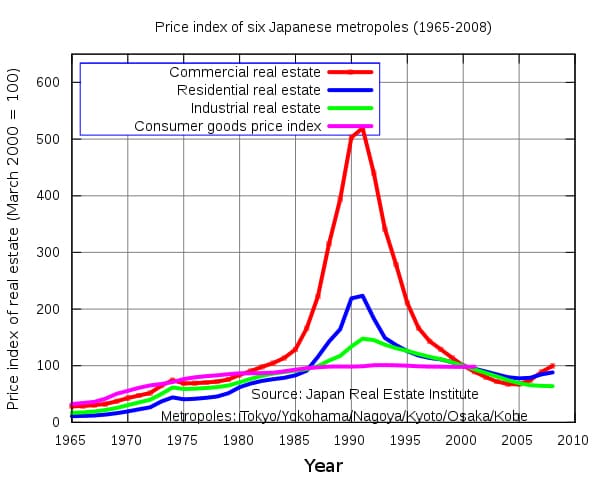
If you had correctly predicted, 30 years ago, the current standing of the Japanese and Chinese economies, you would have sounded ridiculous.
In the early 1980s, both economies were growing at extreme paces. But China was a nation mired in poverty ($250 GDP per capita) that had just begun to open itself to trade, foreign investment, and private industry. Japan, on the other hand, was an industrial and technology behemoth that had taken its place as the second-largest economy in the world, with the highest GNI per capita by 1990.
The picture is much different today. China remains a dynamo, though at times wobbly, while Japan had been stagnant for more than a decade. Will China’s development follow Japan’s into stagnation? What led to the current wide divergence in economic situations and what does it mean for the future?
Three major forces—deflation, over-valuation, and aging demographics—are at play in both economies. Yet they have been a plague in the Land of the Rising Sun, while the Middle Kingdom has gone relatively unscathed due to mitigating factors. Japan may have hit a financial “Great Wall,” but China still has room to maneuver.
Japan’s economy has suffered—and continues to suffer—from deflation, which is slowing the economy to a snail’s pace. Deflationary interest rates—zero or even negative—have been driving consumption down as consumers postpone purchases in anticipation of lower prices. At the same time, the lack of interest payments on accounts combined with a growing part of the population drawing down savings to fund retirement has reduced the savings rate to 23.6% of GDP in 2015, from 32% in 1996, according to World Bank data.
The deflation has continued despite decades of efforts by multiple Japanese administrations (including Prime Minister Shinzo Abe’s Abenomics) to forcefully induce inflation through quantitative easing (central bank bond purchases to increase the money supply). The trend seems likely to continue as the 2015 GDP growth rate (0.47%) and inflation rate (0.79%) were both well below targets, and while 2016 numbers edged out expectations in the last two quarters, yearly GDP growth of just 1% is hardly something to crow about.
China, meanwhile, has not suffered from deflation and seems unlikely to experience this problem in its near future. The Chinese government fixes its currency and has purposely devalued it against the dollar in order to lower the relative prices of its exports, thus encouraging inflation of its currency. Over the past 10 years, China has reduced its high inflation rate to an average of about 3% per year. Data from the National Bureau of Statistics of China show steady growth in consumer spending since at least 2006—right through the financial crisis, even—and the savings-rate peak of more than 50% of GDP, achieved in the late 2000s, has already slid to 48% as more people engage in luxury consumption.

Japan’s economy suffered from a massive asset price bubble based on speculative interests and faulty investments in 1991 that destabilized its entire economy. The degree of speculation on assets such as land was so high that prime real estate in the fashionable Ginza district sold for $139,000 per square foot—leading to calculations that the land comprising the Japanese Palace grounds was worth more than the entire state of California. Japan’s massive banks made extremely risky investments and once the losses became realized, the banks became insolvent and unable to lend. This led the stock market to collapse in 1991. Even now, the Nikkei index has only recovered to 40% of its high.
Against such recent history, the fears regarding over-valuation in the Chinese real-estate and stock markets are rational. Still, the risks there are not nearly as extreme as in Japan. China’s largest bourse, the Shanghai stock exchange, fell by large amounts in both 2015 and 2016 and fell to a low of 30% below its previous high. Over-eager investment and borrowing to finance the investment had led to a stock-market bubble and many predicted it would totally collapse. However, the Shanghai Exchange now stands at 50% above the pre-bubble value, suggesting that the market has weathered the storm and could do so in the future.
China does have the potential to house an over-valued real-estate market. Years of massive construction projects to keep the economy humming have led to an oversupply of buildings priced out the reach of Chinese consumers. Massive sites with highly valued stock lie empty—the so-called “ghost cities” documented so hauntingly by photographer Kai Caemmerer in his internationally acclaimed series “Unborn Cities.” A correction would force investors to face up to the real value of property in China, and possibly lead to capital flight. In response, the Chinese government is easing restrictions on home loans to improve affordability.
Concerns about Chinese real-estate market, though warranted, may miss the bigger picture of the market within China, which still has a constant flow of people from rural areas moving into the cities increasing the demand for urban real estate. Since this flow of people is not expected to abate, urbanization rates will keep increasing, potentially building in sustainable demand that limits the risk of Chinese real estate becoming too wildly over-valued.
FORCE 3: DEMOGRAPHICS

Japan’s aging demographics present a clear problem limiting the nation’s potential for economic growth. Japan’s age-dependency ratio (ratio of those who are dependent on others to those who work) went from 43.4% in 1990 to 64.5% in 2014. In fact, due to low birth rates (well below replacement rate for several years), Japan is the world’s fastest-aging country, with one of every three people being over 60 years old, according to the United Nations World Population Ageing report. Japan also has such low birth rates that its population is expected to decrease from 120 million currently to 87 million by 2060. This portends a dramatic increase in the number of people dependent on others for care and income, coincident with a decline in the overall labor force—a trend that bodes poorly for economic growth.
China already has the world’s largest population of older people, yet it does not suffer nearly as harsh a demographics problem as Japan. Its age-dependency ratio has declined from 51.94% in 1990 to 36.58% in 2015, signaling a major move towards employment age population. There are signs of difficulties ahead, however. A UN report predicts that by 2030, China will rise to sixth in the world for aging, with 34% of its population aged 60 or older. However, when the government lifted its one-child rule last year, the birth rate shot up 11.5%. Without negative population growth, China’s demographics are much less threatening than Japan’s.
In sum, although it is tempting to make superficial equivalencies, China’s woes concerning economic growth are far different from Japan’s. Japan is an extreme case of how a bursting bubble followed by deflation and exacerbated by demographics can prevent economic growth for long periods of time. While China has over-valued stock and real-estate markets, it does not suffer from the threat of deflation or an immediate demographics problem that will cause economic growth to stagnate. Japan may have hit its limit, but China seems to have room to grow.



